Glen Nolan Grant - Mastering Japanese Kanji: (JLPT Level N5) The Innovative Visual Method for Learning Japanese Characters (CD-ROM Included)
Here you can read online Glen Nolan Grant - Mastering Japanese Kanji: (JLPT Level N5) The Innovative Visual Method for Learning Japanese Characters (CD-ROM Included) full text of the book (entire story) in english for free. Download pdf and epub, get meaning, cover and reviews about this ebook. year: 2009, publisher: Tuttle Publishing, genre: Children. Description of the work, (preface) as well as reviews are available. Best literature library LitArk.com created for fans of good reading and offers a wide selection of genres:
Romance novel
Science fiction
Adventure
Detective
Science
History
Home and family
Prose
Art
Politics
Computer
Non-fiction
Religion
Business
Children
Humor
Choose a favorite category and find really read worthwhile books. Enjoy immersion in the world of imagination, feel the emotions of the characters or learn something new for yourself, make an fascinating discovery.
- Book:Mastering Japanese Kanji: (JLPT Level N5) The Innovative Visual Method for Learning Japanese Characters (CD-ROM Included)
- Author:
- Publisher:Tuttle Publishing
- Genre:
- Year:2009
- Rating:3 / 5
- Favourites:Add to favourites
- Your mark:
Mastering Japanese Kanji: (JLPT Level N5) The Innovative Visual Method for Learning Japanese Characters (CD-ROM Included): summary, description and annotation
We offer to read an annotation, description, summary or preface (depends on what the author of the book "Mastering Japanese Kanji: (JLPT Level N5) The Innovative Visual Method for Learning Japanese Characters (CD-ROM Included)" wrote himself). If you haven't found the necessary information about the book — write in the comments, we will try to find it.
Mastering Japanese Kanji can help you greatly reduce the time and effort involved in learning to read Japanese and write Japanese. It does so by introducing a method that is both effective and easy to use in memorizing the meanings and pronunciations of Kanjithe array of characters that are used in the Japanese language to symbolize everything from abstract ideas to concrete nouns.
Learning any of the kanji is a two step process, requiring that you remember both the visual aspect of a character (so you can recognize it when you see it) and the aural aspect (so you will know how to say and, thus, read it). The method employed by Mastering Japanese Kanji will show you how to tackle both of these aspects from the outset, and by so doing enable you to immediately get down to the practical (and fun!) business of recognizing and reading kanji on everything from street signs to newspapers. By the time you finish this book, in fact you will be able to boast of a Japanese vocabulary numbering in the thousands of words.
Key features:
Corresponding CD-ROM helps to reinforce the written material
Teaches the 200 most common kanji and the hundreds of compounds that use include them.
Unique, speciallydesigned drawings and entertaining stories help you learn more quickly.
Sample sentences, along with common words and compounds, expand your vocabulary by showing each kanji used in context.
Strokeorder diagrams show the correct way to write each chapter.
Chapter and cumulative review exercises help ensure master of what youve learned.
Complete indexes show Japanese readings and English meanings for all Kanji.
Contents of the CDROM:
Stroke order animations for all 200 kanji characters.
Native speaker audio recordings of all:
Kanji characters.
Common words and compounds.
Sample sentences.
Glen Nolan Grant: author's other books
Who wrote Mastering Japanese Kanji: (JLPT Level N5) The Innovative Visual Method for Learning Japanese Characters (CD-ROM Included)? Find out the surname, the name of the author of the book and a list of all author's works by series.

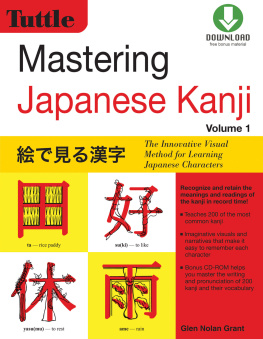
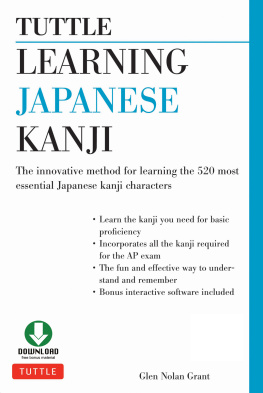
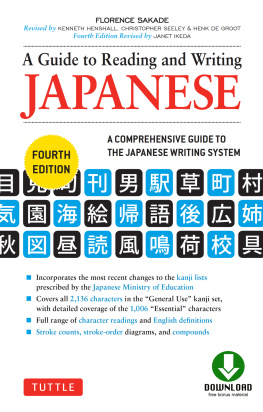
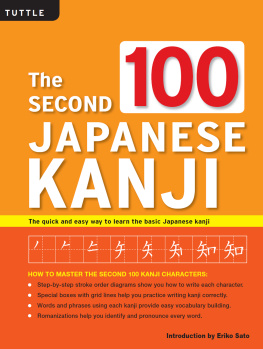

![Eriko Sato - My First Japanese Kanji Book: Learning kanji the fun and easy way! [Downloadable MP3 Audio Included]](/uploads/posts/book/406403/thumbs/eriko-sato-my-first-japanese-kanji-book-learning.jpg)




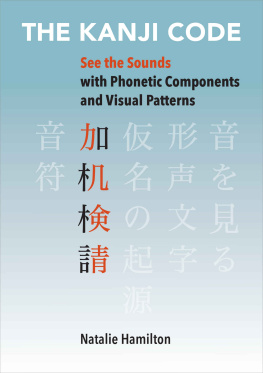
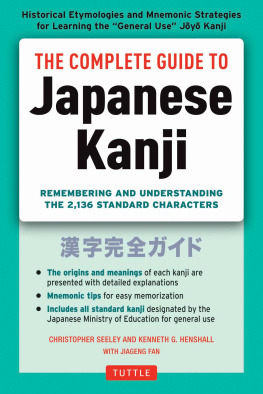
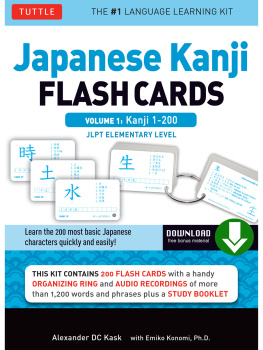
 How to Download the Bonus Material of this Book.
How to Download the Bonus Material of this Book. MEANING Mountain. Our first kanji is one of those wonderful characters whose meaning is obvious at a glance.
MEANING Mountain. Our first kanji is one of those wonderful characters whose meaning is obvious at a glance.  COMMON PRONUNCIATIONS Common ON reading: SAN ( ) Common kun reading: yama ( ) This kanji has only one on-yomi and one kun-yomi (the pronunciation of which together with all others in this book can be heard on the ). To suggest these sounds, lets use the word SAN DWICH for SAN , and yam a ttack for yama . As sandwich will now be a permanent keyword for all kanji sharing the reading SAN , turn to the on-yomi table in the back of the book and write Sandwich in the space next to SAN . Remember that only on-yomi (not kun-yomi ) should be entered in the table.
COMMON PRONUNCIATIONS Common ON reading: SAN ( ) Common kun reading: yama ( ) This kanji has only one on-yomi and one kun-yomi (the pronunciation of which together with all others in this book can be heard on the ). To suggest these sounds, lets use the word SAN DWICH for SAN , and yam a ttack for yama . As sandwich will now be a permanent keyword for all kanji sharing the reading SAN , turn to the on-yomi table in the back of the book and write Sandwich in the space next to SAN . Remember that only on-yomi (not kun-yomi ) should be entered in the table. Now for some common words that make use of this kanji. Theres no need to worry for the moment about being unable to recognize the other characters, as they will all be learned over the course of the book; at this stage, try to see how the meanings of individual kanji combine to form more complex words (look especially at the fourth example below). This is a useful skill, as it will help foster an intuitive feel for the meanings of unfamiliar compounds that you encounter in the future.
Now for some common words that make use of this kanji. Theres no need to worry for the moment about being unable to recognize the other characters, as they will all be learned over the course of the book; at this stage, try to see how the meanings of individual kanji combine to form more complex words (look especially at the fourth example below). This is a useful skill, as it will help foster an intuitive feel for the meanings of unfamiliar compounds that you encounter in the future.